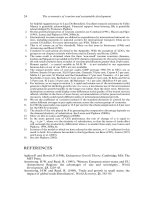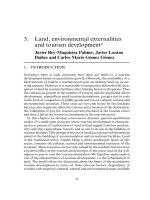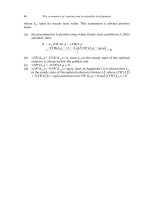THE ECONOMICS OF MONEY,BANKING, AND FINANCIAL MARKETS 662
Bạn đang xem bản rút gọn của tài liệu. Xem và tải ngay bản đầy đủ của tài liệu tại đây (50.82 KB, 1 trang )
630
PA R T V I I Monetary Theory
wages begin to fall, shifting the short-run aggregate supply curve rightward until
it comes to rest at AS3. The economy (equilibrium) slides downward along the
aggregate demand curve until it reaches the long-run equilibrium point 3, the
intersection of the aggregate demand curve AD and the long-run aggregate supply curve (LRAS) at Yn. Here, as in panel (a), the economy comes to rest when output has again returned to the natural rate level.
A striking feature of both panels of Figure 24-5 is that regardless of where output is initially, it returns eventually to the natural rate level. This feature is
described by saying that the economy has a self-correcting mechanism.
An important issue for policymakers is how rapidly this self-correcting mechanism works. Many economists believe that the self-correcting mechanism takes a
long time, so the approach to long-run equilibrium is slow. This view is reflected in
Keynes s often quoted remark, In the long run, we are all dead. These economists
view the self-correcting mechanism as slow because wages are inflexible, particularly in the downward direction when unemployment is high. The resulting slow
wage and price adjustments mean that the aggregate supply curve does not move
quickly to restore the economy to the natural rate of unemployment. Hence when
unemployment is high, these economists, many of whom are followers of Keynes
and are thus known as Keynesians, are more likely to see the need for active government policy to restore the economy to full employment.
Other economists believe that wages are sufficiently flexible that the wage and
price adjustment process is reasonably rapid. As a result of this flexibility, adjustment of the aggregate supply curve to its long-run position and the economy s
return to the natural rate levels of output and unemployment will occur quickly.
Thus these economists see much less need for active government policy to restore
the economy to the natural rate levels of output and unemployment when unemployment is high. Indeed, Milton Friedman and his followers, known as monetarists, advocate the use of a rule whereby the money supply or the monetary
base grows at a constant rate so as to minimize fluctuations in aggregate demand
that might lead to output fluctuations. We will return in Chapter 26 to the debate
about whether government policy should react in a discretionary fashion to keep
the economy near full employment.
Changes in the
Equilibrium
Caused by
Aggregate
Demand
Shocks
With an understanding of the distinction between short-run and long-run equilibria,
you are now ready to analyze what happens when an economy s aggregate demand
curve shifts. Figure 24-6 depicts the effect of a rightward shift in the aggregate
demand curve due to positive demand shocks: an increase in the money
supply (M c), an increase in government spending (G c), an increase in net exports
(NX c), a decrease in taxes (T *), or an increase in the willingness of consumers
and businesses to spend because they become more optimistic (C c, I c). The
figure has been drawn so that the economy initially is in long-run equilibrium
at point 1, where the initial aggregate demand curve AD1 intersects the shortrun aggregate supply AS1 curve at Yn. When the aggregate demand curve shifts
rightward to AD2, the economy moves to point 1+ and both output and the price
level rise. However, the economy will not remain at point 1+ in the long run
because output at Y1+ is above the natural rate level. Wages will rise, increasing the
costs of production at all price levels and the short-run aggregate supply curve
will eventually shift leftward to AS2, where it finally comes to rest. The economy
(equilibrium) thus slides up the aggregate demand curve from point 1+ to point 2,
which is the point of long-run equilibrium at the intersection of AD2 and the longrun aggregate supply curve (LRAS) at Yn . Although the initial short-run effect









